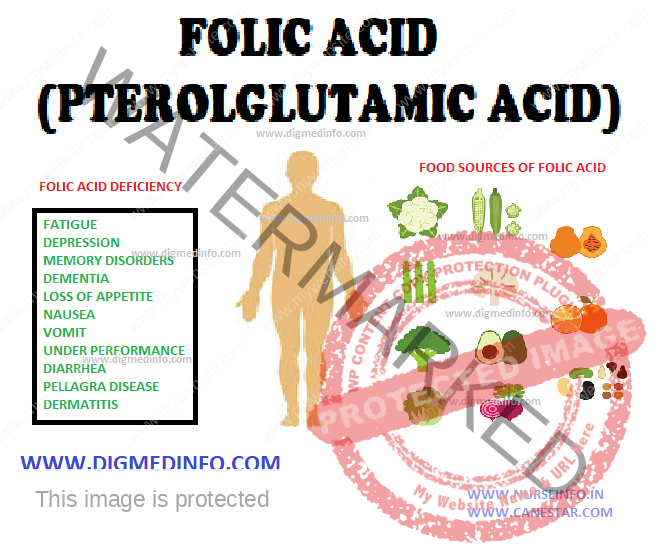FOLIC ACID (Pterolglutamic Acid) – Causes of Folate Deficiency and Treatment
Folic acid molecule consists of a pteridine ring, paraamino benzoic acid and l-glutamic acid. The free form does not occur commonly in nature. Foods and tissues contain several folate compounds (pteroylpolyglutamates).
The main form present in human plasma and CSF is 5-methyltetrahydropteroyl monoglutamate. Rich dietary sources are yeast, liver, nuts, green vegetables, and chocolate. Folic acid is lost by boiling the articles of food in a large volume of water. Average requirement is 200-300 μg/day. The vitamin is absorbed in the proximal small intestine after hydrolysis of polyglutamates. Human body can store about 6-10 mg, especially in the liver.
Megaloblastic anemia has developed in volunteers after 10-20 weeks of dietary deprivation. Dietary deficiency is widely prevalent in India. It is seen most in pregnant women and children. The main reason was deficiency of folates, vit B12 and other deficiencies such as Vit B6 together or singly
Causes of Folate Deficiency
1. Dietary inadequacy of animal foods and green vegetables.
2. Malabsorption states.
3. Increased demands due to pregnancy, lactation, growth and intercurrent illnesses in children.
4. Alcohol intake increases folate requirements.
5. Accelerated erythropoiesis as in hemolytic anemia.
6. Other disorders like tuberculosis, rheumatoid disease, and malignancy increase folate requirements.
7. Several drugs interfere with the metabolism of folates, e.g., amethopterine, pyrimethamine, trimethoprim, hydantoins, oral contraceptives.
8. Folate losses may occur in several disorders of skin and the intestinal tract.
9. Inborn errors of metabolism may interfere with the utilization of folate.
Folate deficiency leads to megaloblastic anemia and similar changes in several rapidly proliferating tissues. In the body the metabolic pathways of folates and vitamin B12 are closely interrelated. In many cases of nutritional anemias, combined deficiencies of iron, folate and to a smaller extent B12 operate. Normal serum folate levels are 4-10 ng/mL and red cell folate is above 100 ng/mL.
Folic acid deficiency occurring in the early period of gestation when the neural tube of the embryo develops, may result in the higher incidence of neural tube defects such as spina bifida and anencephaly. Supplementation of 400 mcg of folate starting from 28 days before and continuing for 28 days after conception reduce the risks of neural tube defects substantially.
Treatment
Dietary deficiency can be corrected by giving 5-10 mg of folic acid orally, in addition to the dietary improvement. Pregnant and lactating women, children and alcoholics require prophylactic supplementation. In poor communities routine folic acid supplementation in pregnancy (1 mg/day) reduces the incidence of premature births. Premature infants should be given folate supplementation.
Folate and vitamin B12 deficiencies are known to elevate serum homocysteine levels and this may lead to abnormal thrombotic tendency.


